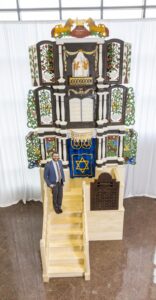Opening the Ark: Bringing a Lost Jewish Synagogue to Life on view in Mayerson Hall Lobby
 The Cincinnati Skirball Museum will reopen for self-touring on Tuesday, April 13. Located on the Cincinnati campus of Hebrew Union College-Jewish Institute of Religion, adjusted museum hours are Tuesdays and Thursdays from 11:00 am to 4:00 pm ET COVID-19 protocols will ensure the safety of museum visitors. Masks are required, guests must stay six feet apart from visitors not in their party, and hands must be washed or sanitized frequently. Space is limited and reservations are required.
The Cincinnati Skirball Museum will reopen for self-touring on Tuesday, April 13. Located on the Cincinnati campus of Hebrew Union College-Jewish Institute of Religion, adjusted museum hours are Tuesdays and Thursdays from 11:00 am to 4:00 pm ET COVID-19 protocols will ensure the safety of museum visitors. Masks are required, guests must stay six feet apart from visitors not in their party, and hands must be washed or sanitized frequently. Space is limited and reservations are required.
In conjunction with the reopening, fifth-year rabbinic student Shmuel Polin has realized his dream with the installation of a fully rebuilt Aron Hakodesh or Holy Ark from a wooden synagogue in Sidra, Poland. Like all others of its kind, this synagogue and its ark were burned to the ground by the Nazis during their occupation of Eastern Europe. Polin’s study of the lost ark and related material resulted in his senior paper, or capstone project, but it is so much more than that. He describes how he first felt moved to embark on this adventure when visiting the reconstructed Chodorow Synagogue at the Museum of the Jewish People in Tel Aviv: “As a rabbinical student, I had not seen anything like it in our synagogues; as an artist and woodcarver, I had never seen anything like it. To me, this meant that a noticeable void had existed. I felt driven to fill the void and attempt to restore something that had been lost. On that day, I committed myself to creating an exact replica of a majestic Holy Ark from one of the vanished wooden synagogues and bringing it back into ritual use. The Opening the Ark Project was the brainchild of that moment.”
Polin’s research coincided with a conservation project on the beloved Polish ark in the Scheuer Chapel on the Cincinnati campus of HUC. Used daily by students for t’filah or prayer, what began as a modest project to make the ark safe for everyday handling turned into analysis of paint and wood, and the discovery of a long-forgotten shipping label affixed to the back of the ark that revealed its specific original location of Schönlanke, Poland. New research conducted by Polin indicated that this precious Polish ark, which came to HUC in 1925 as part of the Berlin Judaica Collection of Salli Kirschstein, was made in about 1759. It had previously been dated about 1740. It is one of the only extant Polish arks of the eighteenth century.
Soaring 20 feet high, the richly colored and symbolic reconstructed Sidra ark is a feat of imagination, engineering, and artistry. Skirball Museum Director Abby Schwartz and Shmuel Polin will tell the story from start to finish and will conduct a virtual tour on April 7 at 12:30 pm ET during an HUC Connect virtual session. This program coincides with Holocaust Remembrance Day which begins at sundown on April 7. In addition to housing the spectacular ark, the lobby of Mayerson Hall has been transformed to include related works of art from the Skirball’s collection. Included are paintings by artist Greta Shreyer, who escaped Vienna in 1938, and who late in her life painted brightly colored canvases of the burning wooden synagogues of Europe. Also on view are ritual objects from the Salli Kirschtein collection that arrived in Cincinnati in the early twentieth century along with the precious Scheuer Chapel ark.
“One of the most meaningful and rewarding aspects of being the director of the Skirball Museum on the historic Cincinnati campus of Hebrew Union College-Jewish Institute of Religion is the opportunity to work with our talented rabbinic students. As this project evolved, there were so many points of intersection with the Polish ark in our Scheuer Chapel, as well as with works of art in the Skirball’s collections that serve to contextualize and enrich our understanding of the recreated Sidra ark,” noted Schwartz.
HUC Connect is sponsored by US Bank. Cincinnati corporate sponsors are Gallagher; Keating, Muething and Klekamp; The PNC Financial Group; Prime Buchholz; USI Insurance Services; and Western Southern Life Insurance. The Opening the Ark Project has been supported by Men of Reform Judaism, The Refusenik Project, Reconstructing Judaism, Jewish Learning Works, Adath Israel Congregation, and GoFundMe Charity.
The Cincinnati Skirball Museum is located in Mayerson Hall on the campus of HUC at 3101 Clifton Avenue. To make reservations to visit beginning April 13, contact Autumn Wheeler at awheeler@huc.edu or (513) 487-3231. To learn more and register for the Zoom program on April 7, click here.
Photo credit:
Fully Rebuilt Aron Hakodesh (Holy Ark) from Sidra, Poland
Shmuel Polin, Cincinnati, 2020
Photography by Ross Van Pelt
The Cincinnati Skirball Museum, founded in 1913 as the Union Museum with the assistance of the National Federation of Temple Sisterhoods, was the first formally established Jewish museum in the United States. Its core exhibition, An Eternal People: The Jewish Experience, as well as temporary exhibitions, portray the cultural, historical, and religious heritage of the Jewish people. In 2015, B’nai B’rith International and HUC-JIR announces the transfer of the art and artifacts of the former B’nai B’rith Klutznick National Jewish Museum, for the purposes of preserving and displaying this distinctive collection of sacred and secular fine and decorative arts. The B’nai B’rith Klutznick Collection augments and enhances the Skirball’s holdings significantly, rendering it among the most prominent Jewish museums between the Alleghenies and the Rockies.